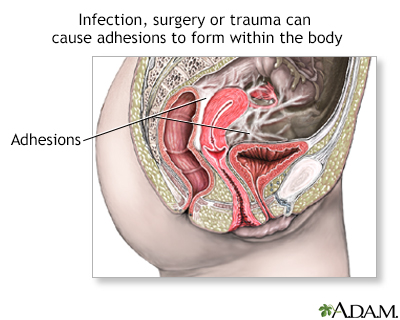Pregnancy SmartSiteTM
Exploratory surgery; Laparotomy; Exploratory laparotomy DefinitionAbdominal exploration is surgery to look at the organs and structures in your belly area (abdomen). This includes your:
Surgery that opens the abdomen is called a laparotomy. DescriptionExploratory laparotomy is done while you are under general anesthesia. This means you are asleep and feel no pain. Your surgeon makes a cut into the abdomen and examines the abdominal organs. The size and location of the surgical cut depend on the specific health concern. A biopsy can be taken during the procedure. Laparoscopy describes a procedure that is performed with a tiny camera placed inside the abdomen. If possible, laparoscopy will be done instead of laparotomy. Why the Procedure Is PerformedYour health care provider may recommend a laparotomy if imaging tests of the abdomen, such as x-rays and CT scans, have not provided an accurate diagnosis. Exploratory laparotomy may be used to help diagnose and treat many health conditions, including:
RisksRisks of anesthesia and surgery in general include:
Risks of this surgery include:
Before the ProcedureYou will visit with your provider and have medical tests before your surgery. Your provider will:
Tell your surgeon or nurse if:
During the week before your surgery:
On the day of surgery:
Outlook (Prognosis)You should be able to start eating and drinking normally about 2 to 3 days after the surgery. How long you stay in the hospital depends on the severity of the problem. Complete recovery usually takes about 4 to 6 weeks. ReferencesLandmann A, Bonds M, Postier R. Acute abdomen. In: Townsend CM Jr, Beauchamp RD, Evers BM, Mattox KL, eds. Sabiston Textbook of Surgery. 21st ed. St Louis, MO: Elsevier; 2022:chap 46. Young S, Tsai S. Management of periampullary cancer. In: Cameron JL, Cameron AM, eds. Current Surgical Therapy. 14th ed. Philadelphia, PA: Elsevier; 2023:589-599. | |
| |
Review Date: 3/31/2024 Reviewed By: Debra G. Wechter, MD, FACS, General Surgery Practice Specializing in Breast Cancer, Virginia Mason Medical Center, Seattle, WA. Also reviewed by David C. Dugdale, MD, Medical Director, Brenda Conaway, Editorial Director, and the A.D.A.M. Editorial team. The information provided herein should not be used during any medical emergency or for the diagnosis or treatment of any medical condition. A licensed medical professional should be consulted for diagnosis and treatment of any and all medical conditions. Links to other sites are provided for information only -- they do not constitute endorsements of those other sites. No warranty of any kind, either expressed or implied, is made as to the accuracy, reliability, timeliness, or correctness of any translations made by a third-party service of the information provided herein into any other language. © 1997- A.D.A.M., a business unit of Ebix, Inc. Any duplication or distribution of the information contained herein is strictly prohibited. | |

 Digestive system
Digestive system Pelvic adhesions
Pelvic adhesions
